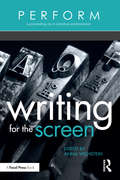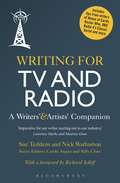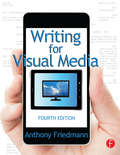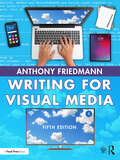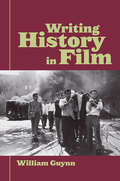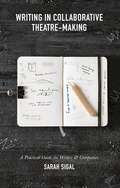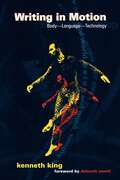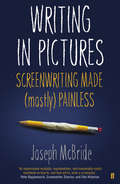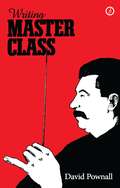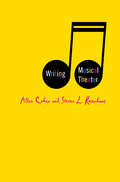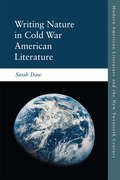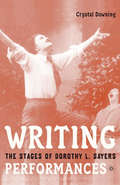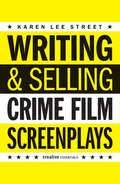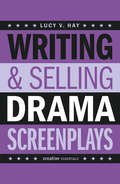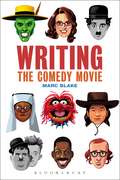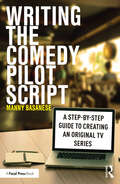- Table View
- List View
Writing for the Screen (PERFORM)
by Anna WeinsteinWriting for the Screen is a collection of essays and interviews exploring the business of screenwriting. This highly accessible guide to working in film and television includes perspectives from industry insiders on topics such as breaking in; pitching; developing and nurturing business relationships; juggling multiple projects; and more. Writing for the Screen is an ideal companion to screenwriting and filmmaking classes, demystifying the industry and the role of the screenwriter with real-world narratives and little-known truths about the business. With insight from working professionals, you’ll be armed with the information you need to pursue your career as a screenwriter. Contains essays by and interviews with screenwriting consultants, television writers, feature writers, writer-directors of independent film, producers, and professors. Offers expert opinions on how to get started, including preparing your elevator pitch, finding mentors, landing an internship, and moving from an internship to the next step in your career. Reveals details about taking meetings, what development executives are looking for in a screenwriter, how and when to approach a producer, and how to pitch. Explores strategies for doing creative work under pressure, finding your voice, choosing what to write, sticking with a project over the long haul, overcoming discrimination, and reinventing yourself as a writer. Illuminates the business of screenwriting in the United States (New York and Los Angeles) as compared to other countries around the globe, including England, Ireland, Peru, France, Australia, and Belgium.
Writing for TV and Radio: A Writers' and Artists' Companion (Writers’ and Artists’ Companions)
by Sue Teddern Nick WarburtonThis essential companion offers invaluable insights and solid, practical guidance to those keen to write for TV and radio.PART 1 explores the nature of the media. It looks at the history of writing drama and comedy for radio and TV through a consideration of its key elements and some of the most successful dramas and comedies of past and present. PART 2 includes reflections and tips from award-winning writers of film, television and radio from the UK, the US and Scandinavia: Sam Bain, Peter Bowker, Elly Brewer, Laura Eason, Ellen Fairey, Nick Fisher, Phil Ford, Jeppe Gjervig Gram, Katie Hims, Rachel Joyce, Marcy Kahan, Rebecca Lenkiewicz, Jan McVerry, Jonathan Myerson, Hattie Naylor, Richard Nelson, Andrew Nickolds, Georgia Pritchett, Mike Walker and Stephen Wyatt. PART 3 offers practical advice on technical aspects of writing for TV and radio including character development, structure and dialogue. It also gives guidance on how to deal with branches of the broadcasting industry, from agents and actors to producers and script editors.
Writing for TV and Radio: A Writers' and Artists' Companion (Writers’ and Artists’ Companions)
by Sue Teddern Nick WarburtonThis essential companion offers invaluable insights and solid, practical guidance to those keen to write for TV and radio.PART 1 explores the nature of the media. It looks at the history of writing drama and comedy for radio and TV through a consideration of its key elements and some of the most successful dramas and comedies of past and present. PART 2 includes reflections and tips from award-winning writers of film, television and radio from the UK, the US and Scandinavia: Sam Bain, Peter Bowker, Elly Brewer, Laura Eason, Ellen Fairey, Nick Fisher, Phil Ford, Jeppe Gjervig Gram, Katie Hims, Rachel Joyce, Marcy Kahan, Rebecca Lenkiewicz, Jan McVerry, Jonathan Myerson, Hattie Naylor, Richard Nelson, Andrew Nickolds, Georgia Pritchett, Mike Walker and Stephen Wyatt. PART 3 offers practical advice on technical aspects of writing for TV and radio including character development, structure and dialogue. It also gives guidance on how to deal with branches of the broadcasting industry, from agents and actors to producers and script editors.
Writing for Visual Media
by Anthony FriedmannThis updated edition of Writing for Visual Media will enable you to understand the nature of visual writing that lies behind the content of all visual media. This unique kind of writing must communicate to audiences through content producers, since audiences don’t read the script. Most media content provides a solution to a communication problem, which the writer must learn to analyze and solve before writing the script. The Fourth Edition strengthens the method for creating content and writing in the correct language and established format for each visual medium, including commercial communication such as ads and PSAs, corporate communications, and training. An extended investigation into dramatic theory and how entertainment narrative works is illustrated by examples and detailed analysis of scenes, scripts and storylines, designed to save writers from typical pitfalls and releasing your creative powers of invention. Writing for Visual Media will help you to develop an improved foundation for understanding interactive media and writing for non-linear content, while gaining the tools to effectively connect with your audience like a professional. Purchase of this book includes access to the companion website, which provides: Sample scripts and video clips of those produced scripts An interactive glossary of camera shots, movements, and transitions Storyboards, scripts, screenplays, and links to industry resource Instructor materials such as PowerPoint lecture slides, a sample syllabus, and a test bank. Visit the site at www.routledgetextbooks.com/textbooks/9780415815857
Writing for Visual Media
by Anthony FriedmannThis updated edition of Writing for Visual Media will enable you to understand the nature of visual writing that lies behind the content of all visual media. This unique kind of writing must communicate to audiences through content producers, since audiences don’t read the script. Most media content provides a solution to a communication problem, which the writer must learn to analyze and solve before writing the script. The Fourth Edition strengthens the method for creating content and writing in the correct language and established format for each visual medium, including commercial communication such as ads and PSAs, corporate communications, and training. An extended investigation into dramatic theory and how entertainment narrative works is illustrated by examples and detailed analysis of scenes, scripts and storylines, designed to save writers from typical pitfalls and releasing your creative powers of invention. Writing for Visual Media will help you to develop an improved foundation for understanding interactive media and writing for non-linear content, while gaining the tools to effectively connect with your audience like a professional. Purchase of this book includes access to the companion website, which provides: Sample scripts and video clips of those produced scripts An interactive glossary of camera shots, movements, and transitions Storyboards, scripts, screenplays, and links to industry resource Instructor materials such as PowerPoint lecture slides, a sample syllabus, and a test bank. Visit the site at www.routledgetextbooks.com/textbooks/9780415815857
Writing for Visual Media
by Anthony FriedmannWriting for Visual Media provides writers with an understanding of the nature of visual writing behind all visual media. Such writing is vital for directors, actors, and producers to communicate content to audiences. Friedmann provides an extended investigation into dramatic theory and how entertainment narrative works, illustrated by examples and detailed analysis of scenes, scripts, techniques, and storylines. This new edition has a finger on the pulse of the rapidly evolving media ecosystem and explains it in the context of writing and creating content. Friedmann lays out many of the complex professional, creative, and commercial issues that a writer needs to understand in order to tell engaging stories and construct effective and professional screenplays. This new edition includes: A new chapter on storytelling A fresh examination of dramatic theory and how to apply it to constructing screenplays Updated discussion of mobile platforms A lengthened discussion of copyright, ethics, and professional development issues An updated companion website with sample scripts and corresponding videos, an interactive glossary, sample storyboards and screenplays, links to industry resources, and materials for instructors such as slides, a syllabus, and a test bank.
Writing for Visual Media
by Anthony FriedmannWriting for Visual Media provides writers with an understanding of the nature of visual writing behind all visual media. Such writing is vital for directors, actors, and producers to communicate content to audiences. Friedmann provides an extended investigation into dramatic theory and how entertainment narrative works, illustrated by examples and detailed analysis of scenes, scripts, techniques, and storylines. This new edition has a finger on the pulse of the rapidly evolving media ecosystem and explains it in the context of writing and creating content. Friedmann lays out many of the complex professional, creative, and commercial issues that a writer needs to understand in order to tell engaging stories and construct effective and professional screenplays. This new edition includes: A new chapter on storytelling A fresh examination of dramatic theory and how to apply it to constructing screenplays Updated discussion of mobile platforms A lengthened discussion of copyright, ethics, and professional development issues An updated companion website with sample scripts and corresponding videos, an interactive glossary, sample storyboards and screenplays, links to industry resources, and materials for instructors such as slides, a syllabus, and a test bank.
Writing History in Film
by William GuynnHistorical film has been an important genre since the earliest silent films. The French Revolution, the American Civil War, the conquest of the New World, World War II--all have been repeatedly represented in film. But how do we distinguish between fictionalized spectacle and authentic historical representation? Writing History in Film sets out the narratological, semiological, rhetorical, and philosophical bases for understanding how film can function as a form of historical interpretation and representation. With case studies and an interdisciplinary approach, William Guynn examines the key issues facing film students and scholars, historians, and anyone interested in how we see our historical past.
Writing History in Film
by William GuynnHistorical film has been an important genre since the earliest silent films. The French Revolution, the American Civil War, the conquest of the New World, World War II--all have been repeatedly represented in film. But how do we distinguish between fictionalized spectacle and authentic historical representation? Writing History in Film sets out the narratological, semiological, rhetorical, and philosophical bases for understanding how film can function as a form of historical interpretation and representation. With case studies and an interdisciplinary approach, William Guynn examines the key issues facing film students and scholars, historians, and anyone interested in how we see our historical past.
Writing in Collaborative Theatre-Making (PDF)
by Sarah SigalThis engaging text explores the role of the writer and the text in collaborative practice through the work of contemporary writers and companies working in Britain, offering students and aspiring writers and directors effective practical strategies for collaborative work.
Writing in Motion: Body—Language—Technology
by Kenneth KingKenneth King is one of America's most inventive postmodern choreographers. His dancing has always reflected his interest in language and technology, combining movement with film, machines, lighting and words both spoken and written. King is also conversant in philosophy, and some of his most influential dances have been dedicated to and in dialogue with the work of such philosophers as Susanne K. Langer, Edmund Husserl and Friedrich Nietzsche. Since the 1960s, he has performed his dance to texts both spoken and prerecorded—texts intended to stand separately as literary works.Writing in Motion spans more than thirty years and is collected here for the first time. It includes essays, performance scripts of King's own work, art criticism, philosophy and cultural commentary. Dense with movement, these writings explode and reconfigure the familiar, crack syntax open, and invent startling new words. Dancing, to King, is "writing in space," and writing is a dance of ideas. Whether referencing Aristotle, Langer, Simone de Beauvoir, MTV, Maurice Blanchot or Marshall McLuhan, King's delightfully lavish prose is very much "in motion."
Writing in Pictures: Screenwriting Made (Mostly) Painless
by Joseph McBrideUnlike most how-to books on screenwriting, Writing in Pictures is highly practical, offering a realistic guide to the screenwriting profession, as well as concrete practical guidance in the steps professional writers take to write a screenplay that comes from the heart instead of the pocketbook. The readeris taken through the nitty-gritty process of conceiving, outlining, constructing, and writing a screenplay in the professional format, with clear and concise examples offered for every step in writing a short dramatic film.Writing in Pictures offers straight talk, no mumbo-jumbo or gimmicks, just a methodical, step-by-step process that walks the reader through the different stages of writing a screenplay -- from idea to outline to character biography to treatment to step outline to finished screenplay. Using well-known films and screenplays, both contemporary and classic, to illustrate its lessons, Writing in Pictures also offers comments from famous screenwriters past and present and insightful stories (often colorful and funny) that illuminate aspects of the craft.
Writing 'Master Class'
by David PownallWriting Master Class is the biography of David Pownall’s play, Master Class (1983), from conception to coming of age. Threaded through the account of the inception and development of the piece are twists of authorial life-story necessary for the telling. Whereas a novel or poem can be kept a secret until it is properly finished, a play has to go out to meet the people early. On the day the script is put into the hands of actors, the soul of the thing passes out of the author’s control. It can be bent, battered, warped – or improved within its being far beyond expectations. As a drama of dictatorship in art and the cleverness needed to evade its worst manifestations, Master Class has been at large for thirty years, produced in twenty countries, in some several times. What has been done to it, how it has fared, is touched upon but the main story in this book is the making of the piece. This is a fascinating insight into the playwright’s craft.
Writing Musical Theater
by A. Cohen S. RosenhausThis guide to the modern musical covers the entire process of creating a show, from finding and working out the initial idea, through to the ways in which writers can market a finished show and get it produced. For the interested theatregoer and writers, it is written in a lively and user-friendly style and illustrated with numerous examples.
Writing Nature in Cold War American Literature
by Sarah DawA study of a key modernist form, its theory, practice and legacy.
Writing Nature in Cold War American Literature (Modern American Literature The New Twentieth Century Ser.)
by Sarah DawExplores the neglected subject of Gothic B-movies in the Americas, Europe, Asia and Africa
Writing Performances: The Stages of Dorothy L. Sayers
by C. DowningAfter Dorothy L. Sayers became famous for her fictional sleuth, Lord Peter Wimsey, she began investigating the mysteries of Anglo-Catholic Christianity, writing plays for both stage and radio. However, because her modernist contemporaries disdained both best-sellers and religious fiction, Sayers has been largely overlooked by the academy. Writing Performances is the first work to position Sayers' diverse writings within the critical climate of high modernism. Employing exuberant illustrations from Sayers' detective fiction to make theoretical issues accessible, the book employs insights from performance theory to argue that Sayers, though a popularizer, presciently anticipated the postmodern ironizing of Enlightenment rationality and scientific objectivity.
Writing Resistance in Northern Ireland
by Aimée WalshWriting Resistance in Northern Ireland is an examination of feminist republicanism(s) in the north of Ireland between 1975 and 1986. Republican prison protest was rife during this period, and fractures opened up between the feminist and republican movements. Despite their shared objective of self-determination, the two movements did not achieve a natural or total congruence. While it has been argued that there is a disjuncture between feminism and nationalism, this book argues for a new perspective on feminist republicanism(s) in the north and tells the story of a niche collective of republican feminists who came to the fore during the Troubles and sought bodily, political and economic autonomy. The book examines source material including historical narratives, jail-writings, journalism, documentary film and literary texts, and paints a vivid picture of a movement of republican feminist women’s writing concerned with political crisis, gender and the nation. Aimée Walsh uses the plural ‘republicanism(s)’ as a way of encapsulating the varied iterations of nationalist feminism, from militant republicanism in Armagh Gaol to a non-violent literary nationalist feminism. This examination of the interaction between nationalism and gender shows how the study of women’s writing can offer a paradigm shift in the history of the Troubles as seen through a feminist lens.
Writing Resistance in Northern Ireland
by Aimée WalshWriting Resistance in Northern Ireland is an examination of feminist republicanism(s) in the north of Ireland between 1975 and 1986. Republican prison protest was rife during this period, and fractures opened up between the feminist and republican movements. Despite their shared objective of self-determination, the two movements did not achieve a natural or total congruence. While it has been argued that there is a disjuncture between feminism and nationalism, this book argues for a new perspective on feminist republicanism(s) in the north and tells the story of a niche collective of republican feminists who came to the fore during the Troubles and sought bodily, political and economic autonomy. The book examines source material including historical narratives, jail-writings, journalism, documentary film and literary texts, and paints a vivid picture of a movement of republican feminist women’s writing concerned with political crisis, gender and the nation. Aimée Walsh uses the plural ‘republicanism(s)’ as a way of encapsulating the varied iterations of nationalist feminism, from militant republicanism in Armagh Gaol to a non-violent literary nationalist feminism. This examination of the interaction between nationalism and gender shows how the study of women’s writing can offer a paradigm shift in the history of the Troubles as seen through a feminist lens.
Writing & Selling - Crime Film Screenplays: Crime Film Screenplays (Writing And Selling Screenplays Ser.)
by Karen Lee StreetAimed at screenwriters, producers, development executives and educators interested in the crime genre, this book provides an invaluable basis for crafting a film story that considers both audience and market expectations without compromising originality. A brief historical overview of the crime genre is presented for context along with an analysis of various crime sub-genres and their key conventions, including: police, detective, film noir, gangster, heist, prison and serial killer. Karen Lee Street focuses on the creative use of these conventions and offers strategies for focusing theme and improving characterisation, story design, structure and dialogue. Paradigms, story patterns and writing exercises are provided to assist the script development process and strategies for revision are discussed along with key questions to consider before approaching creative or financial partners.
Writing & Selling Drama Screenplays: A Screenwriter's Guide for Film and Television (Writing And Selling Screenplays Ser.)
by Lucy V. HayIt may be drama features that win the most awards and kudos from critics, but in the current marketplace you're unlikely to sell a drama screenplay in the way you would a genre script.Breaking down the nuts and bolts of what differentiates drama from genre, Writing and Selling Drama Screenplays considers questions such as:What is 'emotional truth'?What separates stereotypical and authentic characters?What are the different types of drama feature screenplay?How do we make these films, when there's 'no money'?What are the distribution opportunities for dramas?Exploring the ways in which drama and authenticity work, it will empower screenwriters to make their own story and character choices, so they can write and also help to package, finance and even make their own drama features.Writing and Selling Drama Screenplays includes detailed case studies of produced dramas made on both shoestring and bigger budgets, and industry insights from their writers, directors and producers. It looks in-depth at Scottish BAFTA-winning Night People, the iconic coming out movie Beautiful Thing, the touching New Orleans drama Hours, starring the late Paul Walker, and the ambitious true story of Saving Mr Banks, based on the battle of wills between Mary Poppins author PL Travers and Walt Disney himself. It also discusses films such as Brokeback Mountain, American Beauty, The King's Speech, Juno, Erin Brockovich, Changeling and Girl, Interrupted.'A top-notch, cutting-edge guide to writing and selling, not just practical but inspirational. Lucy's distinctive voice infuses the entire journey. Quite brilliant. Here's the woman who'll help you make things happen' - Barbara Machin, award-winning writer & creator of Waking the Dead'Delivers the stirring call to arms that writers must not only write, but take their work to the next level themselves, making sacrifices and taking risks if they want to see their stories on screen' - Chris Jones, Filmmaker, Screenwriter & Creative Director at the London Screenwriters FestivalCheck out Lucy V. Hay's other screenwriting books: Writing & Selling Thriller Screenplays and Writing Diverse Characters for Fiction, Film and TV
Writing the Comedy Movie
by Marc BlakeIt is often suggested that there are 'secrets' to comedy or that it is 'lightning in a bottle', but the craft of comedy writing can be taught. While comedic tastes change, over time and from person to person, the core underpinning still depends on the comedic geniuses that have paved the way. Great comedy is built upon a strong foundation. In Writing the Comedy Movie, Marc Blake lays out – in an entertainingly readable style – the nuts and bolts of comedy screenwriting. His objective is to clarify the 'rules' of comedy: to contextualize comedy staples such as the double act, slapstick, gross-out, rom com, screwball, satire and parody and to introduce new ones such as the bromance or stoner comedy. He explains the underlying principles of comedy and comedy writing for the screen, along with providing analysis of leading examples of each subgenre.
Writing the Comedy Movie
by Marc BlakeIt is often suggested that there are 'secrets' to comedy or that it is 'lightning in a bottle', but the craft of comedy writing can be taught. While comedic tastes change, over time and from person to person, the core underpinning still depends on the comedic geniuses that have paved the way. Great comedy is built upon a strong foundation. In Writing the Comedy Movie, Marc Blake lays out – in an entertainingly readable style – the nuts and bolts of comedy screenwriting. His objective is to clarify the 'rules' of comedy: to contextualize comedy staples such as the double act, slapstick, gross-out, rom com, screwball, satire and parody and to introduce new ones such as the bromance or stoner comedy. He explains the underlying principles of comedy and comedy writing for the screen, along with providing analysis of leading examples of each subgenre.
Writing the Comedy Pilot Script: A Step-by-Step Guide to Creating an Original TV Series
by Manny BasaneseNavigating through the challenging process of writing a comedy pilot, this book will help screenwriters to create an original script for television. Practical and accessible, the book presents a step-by-step guide focusing on the key elements of the process. Incorporating both the history of TV comedy as well as its current evolving state in this age of the dramedy and an ever-increasing variety of broadcast and streaming platforms, the book will serve as a guide for the fledgling sitcom scribe. Author Manny Basanese breaks down the comedy pilot writing process from what may be perceived as an overwhelming, time-consuming mission into a series of much more manageable, smaller steps (from logline to outline to 1st, 2nd and polished draft). Utilizing his experience in Hollywood’s sitcom trenches, the author offers real-world advice on such topics as building the comedy pilot "world," creating memorable comic characters, sound sitcom structure, and the importance of crafting an emotional through line in a comedy pilot. Finally, there is also practical career guidance for marketing this just-completed script and breaking into the industry with advice on various topics such as the value of networking as well as gaining representation in the competitive Hollywood jungle. It is ideal for students of screenwriting and aspiring comedy screenwriters.
Writing the Comedy Pilot Script: A Step-by-Step Guide to Creating an Original TV Series
by Manny BasaneseNavigating through the challenging process of writing a comedy pilot, this book will help screenwriters to create an original script for television. Practical and accessible, the book presents a step-by-step guide focusing on the key elements of the process. Incorporating both the history of TV comedy as well as its current evolving state in this age of the dramedy and an ever-increasing variety of broadcast and streaming platforms, the book will serve as a guide for the fledgling sitcom scribe. Author Manny Basanese breaks down the comedy pilot writing process from what may be perceived as an overwhelming, time-consuming mission into a series of much more manageable, smaller steps (from logline to outline to 1st, 2nd and polished draft). Utilizing his experience in Hollywood’s sitcom trenches, the author offers real-world advice on such topics as building the comedy pilot "world," creating memorable comic characters, sound sitcom structure, and the importance of crafting an emotional through line in a comedy pilot. Finally, there is also practical career guidance for marketing this just-completed script and breaking into the industry with advice on various topics such as the value of networking as well as gaining representation in the competitive Hollywood jungle. It is ideal for students of screenwriting and aspiring comedy screenwriters.
